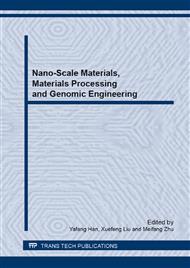[1]
Li. X., Chen. S., Hu. W., Shi. S., Shen. W., Zhang. X., Wang. H. In situ synthesis of CdS nanoparticles on bacterial cellulose nanofibers. Carbohydrate Polymers, 2009,76, 509-512.
DOI: 10.1016/j.carbpol.2008.11.014
Google Scholar
[2]
Caseri. W. Nanocomposites of polymers and metals or semiconductors: Historical background and optical properties. Macromolecular Rapid Communication, 2000,21, 705–722.
DOI: 10.1002/1521-3927(20000701)21:11<705::aid-marc705>3.0.co;2-3
Google Scholar
[3]
Yano. H., Sugiyama. J., Nakagito. A. N., et al. Optically transparent composites reinforced with networks of bacterial nanofibers. Advance materials, 2005, 17(2) 153-155.
DOI: 10.1002/adma.200400597
Google Scholar
[4]
Nogi. M., Handa. K., Nakagaito. A. N., Yano. H. Applied Physics Letter, 2005, 87, 243110.
Google Scholar
[5]
Gelin. K., Bodin. A., Gatenholm. P., Mihranyan. A., Edwards. K., Strømme. M. Characterization of water in bacterial cellulose using dielectric spectroscopy and electron microscopy. Polymer, 2007, 48(26), 7623–7631.
DOI: 10.1016/j.polymer.2007.10.039
Google Scholar
[6]
Takashi. N., Ikuyo. M., Koichi. H., All-Cellulose Composite, Macromolecules 2004, 37, 7683-7687.
Google Scholar
[7]
Nogi. M., Yano. H. Transparent Nanocomposites Based on Cellulose Produced by Bacteria Offer Potential Innovation in the Electronics Device Industry. Advance Material, 2008, 20, 1849–1852
DOI: 10.1002/adma.200702559
Google Scholar
[8]
Ifuku. S, Nogi. M. , Abe. K, Handa. K., Nakatsubo. F., Yano. H. Surface Modification of Bacterial Cellulose Nanofibers for Property Enhancement of Optically Transparent Composites: Dependence on Acetyl-Group DS. Biomacromolecules, 2007, 8, 1973-1978.
DOI: 10.1021/bm070113b
Google Scholar
[9]
Ummartyotin. S., Juntarob. J., Sain. M., Manuspiya. H., Development of transparent bacterial cellulose nanocomposite film as substrate for flexible organic light emitting diode (OLED) display. Industrial Crops and Products, 2012, 35, 92– 97.
DOI: 10.1016/j.indcrop.2011.06.025
Google Scholar
[10]
Choi, M., Kim, Y., Ha, C.S., Polymers for flexible displays from material selection to device applications. Prog. Polym. Sci. 33, 581–630.
DOI: 10.1016/j.progpolymsci.2007.11.004
Google Scholar
[11]
Bergstroèm. L., Stemme. S., Dahlfors. T., Arwin. H., Oèdber. L., Spectroscopic ellipsometry characterisation and estimation of the Hamaker constant of cellulose. Cellulose, 1999, 6, 1-13.
Google Scholar
[12]
Nogi. M, Ifuku. S., Abe. K., Handa. K., Nakagaito. A. N., Yano. H. Fiber-content dependency of the optical transparency and thermal expansion of bacterial nanofiber reinforced composites. Applied Physics Letter, 2006, 88, 133124.
DOI: 10.1063/1.2191667
Google Scholar


